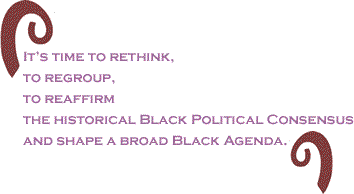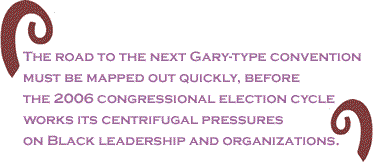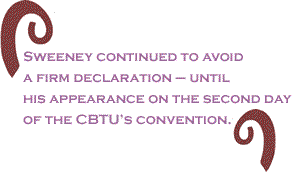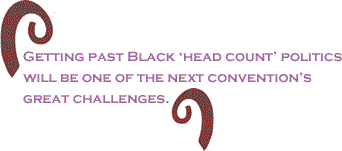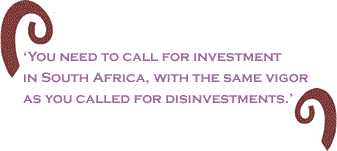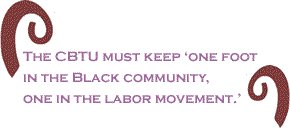
|
|||||||||||||||||||||
|
“We have no quarrel with any union or individual, unless they question our right to be in the room.” – William Lucy, President, Coalition of Black Trade Unionists (CBTU) “I sit on the AFL-CIO Council. Those boys don’t ask me anything.” – Clayola Brown, Executive Council, AFL-CIO and CBTU We must build an independent political struggle that will define priorities and behavior of both parties.” – Rev. Jesse Jackson, President, Rainbow/PUSH Coalition “It’s time to go back to Gary,” William Lucy told 1,500 delegates to the 34th annual convention of the Coalition of Black Trade Unionists (CBTU), meeting in Phoenix, Arizona, last week. “It’s time to go back to Gary to talk among ourselves as trade unionists, as social activists, as political leaders, as academics about what it will take to move our communities forward.” Lucy, Secretary-Treasurer of the American Federation of State, County and Municipal Employees (AFSCME) and President of the CBTU since its founding in 1972, was also a convener of the historic National Black Political Convention in Gary, Indiana, that same year. In the intervening decades, Black fortunes have waxed and waned – depending on who’s doing the measuring. However, under George Bush’s administration, African Americans as a people have been dealt a series of catastrophic blows, including assaults from within the labor movement, itself.
Lucy’s call-to-convention reflects the growing realization that it’s time to rethink, to regroup, to reaffirm the historical Black Political Consensus and shape a broad Black Agenda, in the spirit of Gary and of Black political conventions dating back to 1830. CBTU delegates agreed, passing a resolution for a “national convocation of grassroots advocates and leaders to achieve consensus about the elements of a Black Agenda, which would then be presented to organizations and forums for development and discussion.” The road to the next Gary-type convention (not necessarily at the same location) must be mapped out quickly, before the 2006 congressional election cycle works its centrifugal pressures on Black leadership and organizations, pulling them into various camps and campaigns at the expense of the national Black mission. CBTU President Lucy stressed the urgency of the project:
Crisis upon crisis African American labor began the year reeling from the disappearance of 168,000 Black union jobs in 2004 – a staggering 55 percent of the total union jobs lost – and from two body blows delivered in quick succession by “allies” in the trade union movement. First, the AFL-CIO, under President John Sweeney, froze the CBTU and other non-white-male constituent groups out of Big Labor’s 2004 election efforts. Labor refused to fund the grassroots campaign activities of labor’s six constituency groups – now organized as the Labor Coalition for Community Action – despite the fact that Blacks, other minorities and women make up 60 percent of union membership.
Then, five unions led by Service Employees International Union (SEIU) President Andrew Stern – collectively known as the Group of Five, or G-5 – demanded that the Executive Council of a reorganized AFL-CIO be shrunk to 13 or 16 members, from the current 54. The council was expanded when Sweeney was elected ten years ago, specifically to make room for minorities and women. (It know includes seven African Americans.) But under the original G-5 dissident proposal, only the heads of the labor federation’s largest unions would have a seat at the executive table – a catastrophic turning back of the clock for non-whites and women. Blacks also feared that the AFL-CIO’s Central Labor Councils, where urban minority influence is strongest, would be weakened under the “reforms” of the G-5 dissidents: the SEIU, Teamsters, Laborers, UNITE-HERE, and United Food and Commercial Workers union (UFCW) – many of whose African American members and leaders are represented in the Coalition of Black Trade Unionists. Facing the G-5’s ultimatum to withdraw from the labor federation if their demands are not met, President Sweeney terminated the jobs of one-third of his headquarters staff, in early May. However, the SEIU’s Andrew Stern and his allies called the streamlining “too little, too late,” and continued on the brinkmanship path. And, although Sweeney made informal promises to stand by representation of minorities and women on the Executive Council and to strengthen state federations and Central Labor Councils, he continued to avoid a firm declaration – until his appearance on the second day of the CBTU’s convention in 100-plus degree Phoenix:
To the delegates assembled in the huge Phoenix Civic Center island of air conditioning, this sounded like victory. The same day, Sweeney had been endorsed by the powerful United Auto Workers (UAW) – apparently putting him over the top for reelection at the AFL-CIO’s convention in Chicago, July 23. Flush with confidence, Sweeney seemed to blame the dissidents for George Bush’s victory, in November.
Of course, it was under Sweeney that the CBTU and other constituent groups were denied federation funds for 2004 election activities – a fact known by virtually everyone in the convention hall. But Sweeney was on a roll:
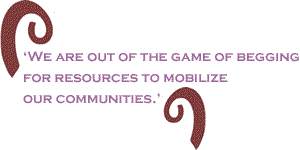
Sweeney’s last remarks brought down the house, but they could not alter the resolve of CBTU’s leadership to break with, in Bill Lucy’s words, “the politics of paternalism.” “I pledge to you that we are out of the game of begging for resources to mobilize our communities,” Lucy told delegates in his opening day speech. “Whether we are accepted by the powerful players in labor or not…we will continue to come to the aid of unorganized workers whenever we can with or without the help of the so-called big players. We will help to mobilize our communities…. “We are out of the begging business. We can’t waste time chasing rainbows.” Black folks will seek their own solutions and finances, on the road to the next “Gary” convention. Dissidents wake up too late
If SEIU President Andrew Stern thought he might turn the CBTU from its position on constituency group representation, he was mistaken. Black SEIU Executive Vice President Gerald Hudson, a respected, veteran organizer, made his union’s case for “reform” to SEIU delegates at a conference room in Phoenix – and caught hell from some of them. “We’re having a big problem” with the divisions in labor, said one delegate from California. “The newspapers are saying Andy [Stern] is fighting Sweeney. But we have to face ‘The Terminator’ [union-hating Governor Arnold Schwartennegger]. Some members are furious.” Said another delegate, “When I have a problem with my union, I don’t start talking about decertification.” Another delegate: “Ask me, don’t tell me” about the positions union leadership is taking. In recent weeks, some of the five dissident union leaders softened their verbal positions on inclusion of constituent groups in the Executive Council, but whatever modifications that were made came very late in the game, and appear to have only been circulated in-house. Hudson said the new reform proposals would allocate “four or five” of twenty or so council seats to constituents. “The G-5 are increasingly getting to the point where they’re saying the right things,” Hudson assured the SEIU delegates. However, the CBTU convention’s collective mind was made up. The full convention resolved to resist any diminution of the Executive Council; that a department be created to build formal relationships among labor and community institutions; and that constituent group leadership and structures (the six-organization Labor Coalition for Community Action) be integrated into the new department’s activities. In other words, the massed CBTU demanded that the institutional role of non-whites and women in AFL-CIO structures become deeper and stronger – a functional part of the organizational chart – rather than an informal afterthought. Independence is a necessity John Sweeney’s failure to fund AFL-CIO constituent groups during the 2004 campaign, followed by the Group of Five’s bid to read them out of the Executive Council, on top of the worst setbacks for Black workers since the demise of Jim Crow, all combined to make a much more independent Black labor strategy inevitable. Traditional Black organizations also found themselves cut out of the 2004 campaign money loop by their erstwhile “friends” in the Democratic Party – a clear precursor to jettisoning them entirely in favor of what Keith Jennings, President of the African American Human Rights Foundation and an advisor to CBTU, calls “corporate-selected” Black leadership.
Independence is, therefore, not just an option – it is necessary for the survival of the Black polity. Rev. Jesse Jackson put it well, in one of two CBTU convention Town Hall meetings:
William Lucy, the consummate coalition builder, has “no quarrel with any union or individual, unless they question our right to be in the room,” a position seconded by CBTU Executive Vice President Willie Baker, a VP of the (Group of Five aligned) United Food and Commercial Workers Union: “If others pick and choose who goes into the room” we are in trouble. CBTU Executive Council member Clayola Brown, a Vice President of the (Group of Five aligned) UNITE-HERE union, says Black workers have the same concerns throughout organized labor. “I sit on the AFL-CIO Council. Those boys don’t ask me anything,” Clayola told the convention crowd. “Many of us have been speaking at opposite ends” from our union leaders. “But if they [whites] don’t speak to Black people….” White arrogance has defined the limits of collaboration across racial lines. And nothing has been more hurtful to Black leadership than the signals emanating from whites in labor and the Democratic Party, that African Americans were somehow a burden in 2004, dragging both institutions down to defeat. “In 2004 the minority community voted in higher numbers than ever before,” said Willie Baker. “We are a larger percentage of the voters than ever before. Eighty-nine percent went for progressive or liberal candidates – and that’s right on the average for the past 30 years. I think those numbers speak to our role in organized labor.” Only bare majorities of white unionists voted for John Kerry. White labor and Democrats “should ask our advice,” said Baker. “Maybe we’d all be better off.” “Some ‘constituent groups’ got over $100 million,” said CBTU Executive Council member Nat LaCour, sarcastically referring to whites – and their vote went down. “If CBTU and APRI [the Black-led A. Phillip Randolph Institute] had that kind of money, we’d have gotten 100 percent of the vote.” LaCour is Executive Vice President of the American Federation of Teachers, and sits on the AFL-CIO Executive Council. The prospect of an Executive Council comprised of “fifteen white males, one African American male, no women,” is “ridiculous,” he fumed. Labor legend Henry Nicholas, of AFSCME, blames white failures for the disarray in labor and progressive politics. “Unless we do something now, we will wake up and find there are no jobs, here in the United States,” he warned, urging CBTU delegates to take vacation time to attend the AFL-CIO’s Chicago convention, in July. “We’re the only ones that can save the labor movement.” Rev. Jackson was ubiquitous at the convention, speaking on Mexican-Black relations (“We must not allow Black Americans to be pawns, and Mexicans to be scapegoats”) and extension of the Voting Rights Act (he’s leading a march in Atlanta, August 6). Jackson said white Democrats and unionists have it backwards – they are the unreliable elements: “They’re not pulling their weight, depending on us to deliver them. Those who can’t pull their weight want to pull us.” In such an environment, there is no choice but for Blacks to pull together, guided by their own instincts and experiences. The corporate infection
“At the end of the day, I wonder what’s going to happen to the most loyal people in the House of Labor,” said staunch labor ally Bennie Thompson, the Black Congressman from Mississippi. Thompson was eager to talk about the “stupid” letter sent by the SEIU, which criticized the Congressional Black Caucus as a body for “giving Wal-Mart an opportunity to fashion a false image that they are friends of African Americans and working people generally.” Laughing derisively, Thompson pointed out that the Caucus averages 90 percent support for labor. “The SEIU…think that if they support you they own you. Sometimes, you’ve got to take the chains off,” said Thompson, to rich applause. “When I look at the [union] leadership, it doesn’t reflect the membership. Their attitude is, we know what’s best for you.” Fellow Democrats came in for similar criticism. “Every time we learn the game, they change the rules. Guess who was running the 527s,” the funding mechanisms that received the bulk of campaign monies in 2004? “Somehow, we didn’t have the resources anymore.” But of course, there is a problem in the Congressional Black Caucus (see BC, May 12 and April 28, 2005), a spreading corporate infection that has thoroughly corrupted a hardcore half-dozen members and caused fifteen – more than a third – to vote with Republicans on “bright line” issues in April. If the next Gary-type convention is to have any meaning, it must deal with the contagion in high Black places, and remake the political terrain that spreads it. As one speaker reminded the Phoenix gathering, it was the great African revolutionary Amilcar Cabral who said, we must struggle against our own weaknesses. However, it is extremely difficult to focus on the internal contractions within a group that is besieged by forces determined to crush their basic democratic rights. Extend the Voting Rights Act In 2007, elements of the Voting Rights Act of 1965 will come up for renewal by Congress. Most important is the pre-clearance provision, Section 5, which requires that jurisdictions covered by the Act submit any changes in voting procedures for review by the U.S. Justice Department. In one of many CBTU workshops, Debo Adegbile and Jacqueline Berrien, of the NAACP Legal Defense and Education Fund (LDF), explained that pre-clearance puts the burden on the state. “The government is forced to turn the lights on. It makes the jurisdiction come forward and show that it is not discriminating,” said Adegbile.
Opponents of Voting Rights renewal will point to Black electoral successes as proof that the legislation has outlived its usefulness. “They say, ‘We now have 43 Blacks in the Congress. Why do we need the Voting Rights Act?’” said Adegbile, reminding the room that Blacks were represented in Congress during Reconstruction, too, but were later made to disappear. “Reverse discrimination” is the war whoop on every right-winger’s lips. “Any law that helps Black people,” said the LDF’s Berrien, “has been challenged in the last decade or two, as hurting white people.” Therefore, it’s not too early to mobilize for the 2007 showdown. “We won in Florida. We won in Ohio,” said Rev. Jesse Jackson, rallying support among CBTU delegates for the August 6 march in Atlanta. “Voting Rights is under attack. Unless we fight back, they will take back.” Next Wednesday, June 8, the abominable Black Judge Janice Rogers Brown comes up for a vote in the U.S. Senate. If confirmed under the truce engineered by “moderates” of both parties, she will sit on the federal appellate court that decides most voting rights disputes. “We ‘protected’ minority voting rights in the Senate. But they didn’t protect ‘minority’ voting rights outside the Senate,” said Rev. Jackson. “This is a setback for labor. The Democrats in the Senate and Blacks are not on the same page. “I would rather have the 1954 court [nine white men] than the 2005 court.” The first Gary convention didn’t have to confront corporate-engineered Black judicial, cabinet, and electoral candidates. Getting past Black “head count” politics will be one of the next convention’s great challenges. Coalition-building Racial math can often hide political realities. But the numbers show the prospects for non-white rule are good, according to Town Hall panelist Dr. Juan Andrade, of the U.S Hispanic Leadership Institute:
Dr. Andrade lamented that non-white coalitions – and coalitions between people of color and labor – have often had trouble governing. That’s no mystery to Meizhu Lui, a woman of Chinese descent who is Executive Director of United for a Fair Economy. “Some of the first unions in this country were organized against Chinese labor,” Lui pointed out. Nevertheless, “White guys have done a lousy job. It’s up to us, the United People of Color.” Yet racial and ethnic coalitions are problematic in a United States that has always defined whites as normative and Blacks as the ultimate “other.” In a new book titled Who is White?: Latinos, Asians, and the New Black/Nonblack Divide, Dr. George Yancey argues that, by 2050, most Latinos and Asians will consider themselves white, thus preserving an effective “white” majority into the far horizons. (See BC, “The Browning and Yellowing of Whiteness,” May 12, 2005.) Dr. Yancey concludes:
A July 31, 2002 Los Angeles Times article, headlined “The Great White Influx,” reported that “regardless of color, two-thirds of immigrants choose [the ‘white’] designation on census replies. For some, it's synonymous with America.” The next Gary convention should not anticipate that immigration will necessarily increase the numbers of future Black allies. However, regardless of how other “minorities” identify themselves, “Either we are going to organize and share power or we’re going to fight over crumbs,” said the omnipresent Jesse Jackson. Switching Gears on South Africa
“We were successful in driving money out of South Africa, but we weren’t concerned where it went,” said Bill Lucy, summing up the Free South Africa Movement’s struggle to force U.S. corporations, foundations and governments to withdraw investment during apartheid. The CBTU was the first U.S. labor organization to call for an economic boycott against South Africa, in 1974. Now Willy Madisha, President of the Congress of South African Trade Unions (COSATU), was in Phoenix, imploring his African American trade union comrades to reverse gears. U.S. corporate investments never returned to South Africa, but went instead to low-wage, union-oppressing countries. “The call we are making to you, brothers and sisters, you need to call for investment in South Africa, with the same vigor as you called for disinvestments.” Madisha told a workshop audience and the full convention that South Africa has lost 180,000 jobs in the clothing and textile industries, much of it to China, vastly complicating the Black government’s attempts to deal with illiteracy, sanitation, AIDS, and lack of housing and electricity – “the legacy of apartheid.” The African National Congress (ANC) governs with the support of its partners in the revolution: COSATU and the South African Communist Party. “Up to this minute,” said the trade unionist, “the ANC has not sold out. We hope it stays that way.” But the forces of globalization and privatization exert great pressures on the ANC. “Our government nearly fumbled, when it tried to privatize,” Madisha informed the workshop. “We fought them in the streets, toe to toe. They stopped privatizing, although they never announced they were stopping.” Harold Rogers, a veteran member of CBTU’s International Committee, said “in the 70s and 80s there was a great deal of interest in Africa. Some of it was romantic. In the late 90s, interest in Africa waned.” Currently, only about five percent of U.S. tourists to Africa are African American. COSATU President Madisha remembers when the romance wore off, after Nelson Mandela formed his government. “After that victory – which you won yourselves – after winning that victory, you stopped. You said, ‘Oh, victory has been won.’” The African American listener is struck by the similarity to post-Sixties Black America, when “Ain’t No Stoppin’ Us Now” filled the airwaves. “In actual fact,” said Madisha, “the struggle started the day that the democratic government took over…. We have all these rights, but they are useless as long as we face these kinds of problems.” Yet another poignant comment: “Already, young people in our country begin to forget where they came from. If they forget our revolution, there will be no future.” How many African Americans understand the significance 1955, 1963, 1968 – or the Gary convention of 1972? The COSATU leader educated his workshop on the role of women in his movement. Women must make up no less than 50 percent of union leadership, and comprise at least 30 percent of party parliamentary lists. More than 30 percent of the ANC’s cabinet ministers are female. In CBTU, women are a majority of convention delegates and 17 of 41 Executive Council members – 41 percent. The Women’s Conference is possibly the biggest draw of the convention. They are working women and organizers, and anything but compliant – ready for Gary, wherever it’s held. Awesome challenges
CBTU advisor Keith Jennings arrived in Phoenix with a clear head, and a list of challenges that he outlined to a meeting of the Executive Council:
“The political reality is different now than in 1972 or even ’92,” said Jennings, an Atlanta-based political scientist. He noted that African Americans are returning to the South, “the source of Black strength. We need to relearn lessons” and apply them to “local elections, community empowerment.” The CBTU must keep “one foot in the Black community, one in the labor movement.” Most critically, Blacks must “formulate ‘terms of engagement’ for those who want to work with us, while we pursue our goals of social justice.” If the next Gary-type convention is to be a true watershed in the African American journey, there must also be ‘terms of engagement’ among Black folk. Perhaps the most dramatic change that has occurred in Black America over the last 33 years, is massive corporate penetration of African American political structures, both old and new. As the least contaminated major Black organization, the Coalition of Black Trade Unionists is an ideal convener for an overdue gathering of sincere and authentic sectors of the Black polity. Everybody Black was invited to Gary. In these times, it would be best if some folks don’t show up. |
Your comments are always welcome. Visit the Contact Us page to send e-Mail or Feedback or Click here to send e-Mail to [email protected] e-Mail re-print notice
If you send us an e-Mail message we may publish all or part of it, unless you tell us it is not for publication. You may also request that we withhold your name. Thank you very much for your readership. |
| June 2 2005 Issue 140 |
|||||||||
|
|||||||||
|
|
|||||||||
| Printer Friendly Version | |||||||||
 |
|||||||||
 |
|||||||||
| |
|||||||||
| |
|||||||||






















